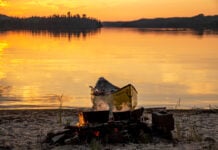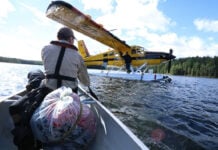What an eyesore. The campsite, an idyllic pitch of granite and pine in central Algonquin Park, had been blemished by of a couple of yahoo bushcrafters.
They had cut down standing trees to build a makeshift lean-to shelter and lashed it together with cordage made of young saplings. An elaborate kitchen area, complete with a table, storage compartments and a circle of benches was constructed. Conifer boughs were cut to make a bed, set in front of a large fire pit away from the designated metal fire grate placed by the park wardens.
I saw them paddle off before I reached the site. They were dressed in camouflage fatigues and I imagined the majority of their gear was purchased at army surplus stores. The only things not green were their bright white Tilley hats disappearing into the distance.
They weren’t doomsday preppers practicing for a worst-case scenario or campers playing some dystopian future fantasy game—they were worse. They were fake bushcrafters.
The term bushcraft has been around for a long time. It’s generally defined as skills to help one thrive in the wilderness. To quote bushcrafter Steve Watts, “Without the context, it’s just arts and crafts.”
Bushcraft techniques have been employed for millennia by indigenous peoples. Today, bushcraft is enjoying an in-vogue moment and become a bit of a catch-all term.
Bushcraft can refer to everything from firecraft, tracking, navigation by natural means to higher-impact techniques inappropriate (and even illegal) in some managed wilderness areas—like cutting boughs for bedding or live branches for cordage, and non-emergency shelter building. Don’t even get me started on the campers who attempt to reestablish the configuration of their living rooms’ furniture at campsites and leave it for the next camper and have the audacity to call it bushcraft. It’s crappy camp carpentry.
I find a fundamental difference in the way the wilderness is treated by people who believe they’re out in the woods to thrive versus survive. Real bushcrafters practice leave no trace camping—the guys I met were just ignorant slobs who watched way too many “wilderness survival” YouTube videos and were playing make-believe. It’s when less-than-ethical techniques practiced by unskilled campers then show off their exploits on their social media pages and video channels that bad behavior can get passed off as the norm for others to adopt. It’s creating a strong movement of false prophets.
I find North America to be far more plagued by false bushcraft messiahs than Europe or Australia. For some, the term bushcraft seems to be just another way to say you’re a camper that’s mixed both modern wilderness skills and primitive techniques. Closer to home, it’s too often a way for buddies to act out a survival TV show for the weekend.
Building a shelter to weather a storm is definitely a wilderness skill. Going to a protected wilderness park on a warm summer day, cutting down living trees to build a half-ass lean-to and leaving the structure intact when you leave—well, that’s just ignorance.
Would it be different if these immoral bushcrafters kept clear of provincial, state and national parks and practiced their skills in remote areas, like Crown land? Some say, yes, but I’m undecided. Regardless of the designation of the land you camp on, everyone should follow leave no trace principles. You never know when another happy camper will be paddling by next.
Kevin Callan is the author of 18 books, including the best-selling The Happy Camper and his popular series of paddling guides.
This tripod cooking technique is a low impact bushcraft skill and easy to dismantle And leave no trace—Kevin Callan approved. | Photo: Ontario Tourism / Goh Iromoto








based on the fake bushcraft article and the impacts we see all too often maybe it’s time to give some page to Leave No Trace research, data, education and promotion. http://www.leavenotrace.ca
Good point and unfortunately there are a lot of innocent “bushcraft wanna be’s” out there who read all those backcountry narratives written exactly for these people. Extolling a trove of tech gear to keep them from getting lost or ways to cook a moose/boil coffee/and recharge your cell phone all with a camp stove being hawked by some outdoor guru. This and the guys mentioned who “survive” in their backyard video about erecting a lean-to with hundreds of feet of tarp, copious yards of line, etc. and are bragging about being survival shelter experts. Basic self-reliance is hardly even discussed…nothing on how to read a map or use a compass or orient because you have a GPS that recharges using gnat farts and comes in several earth-friendly colors. I firmly believe that all outdoor advice needs qualifiers that offer sources of more information or at least warn of the cons about all the pro tooting someone gives regarding the utility of a product.
So true! All one has to do is search #bushcraft in Instagram and there hundreds of thousand of posts from full on campsites to a pic of someone’s new knife. Very few identify that a. They have permission to do this on private land b. This is allowed on the public land they are using
All the wannabes read the post (and more often than not, a YT video) and then venture off into the wild blue yonder to try and mimic what they’ve “learned”
Sadly, it is a that double-edged sword, popularizing the wilderness for recreation to raise awareness and stewardship, can also mean more people flocking to parks, back-country, and, if they bother to research, crown land. Unless they do appropriate self education or take courses and workshops, there is the danger of misguided or ignorant people having such huge impacts where they go, because they either don’t know any better, don’t care, or can’t be bothered. (“its not a sin if nobody catches me”). Its even more apparent now that more such people are going camping, not having experienced ethical LNT camping as a child at camps or with organizations such as Girl Guides or Scouts. There should be a quick orientation video at visitor centers they have to sit through about proper camping etiquette and practices, but even that would not necessarily be effective. Thankfully, the more remote, harder to access areas, still see fewer people.
Well said Kevin. It makes my blood boil when I come across this atrocious behavior which is far too often lately.
The natural places have always been assaulted by unscrupulous people who extort it’s beauty for financial gain. The people who treat our wilderness places with wonton abandon are hacks. All living things deserve respect – that includes the saplings these people hack down for a few seconds of video.
I totally agree with you – living with the earth is a skill which all campers and outdoor enthusiasts should embrace.
When you leave only tracks – you are a true camper.
Thank you so much for writing this article.
Well said. I am glad you are bringing attention to this issue. Destruction of nature for social media attention is disgusting.
To some extent the US is experiencing the same problem and it has increased since the pandemic when there is now no rangers or outfitters to expound LNT requirements when a permit is issued in person. While it wouldn’t completely solve the problem, permit issuance in person would help.
It does seem to be a critical time between someone deciding they would like to experience wilderness camping (or even camping in general) and when they must be exposed to LNT principles and wilderness ethics. Maybe they should make you watch a video when you check out at REI!
Great article! I definitely noticed some fake bush crafting recently. I think the past year definitely exasperated this issue. With Covid hitting and governments encouraging people to get outside, so many people ventured out for the first time or decided to try new skills. This would normally be great, but the space for people to learn proper leave no trace principles and ‘beginner’ skills (take your pic at paddling, fires, bushcraft) just wasn’t ready for the huge influx of people.
Hold the phone …
That is an old expression. So to is, Greenhorn, Wet behind the ears, Newbie, Novice, and Tenderfoot. All of course referring to people who are learning their “what ever they are learning.” I involve myself in many hobbies from kayak to rustic woodcraft, astronomy to novel writing. Everyone is new at something at some point, and then they get better, that’s learning. Let the newbies make mistakes, share their novice knowledge in an article, or in YouTube. The high and mighty and self aggrandizing know it all’s who take great pleasure in downplaying even a bit of knowledge to supplant their vast expansive ego’s on the subject.
I solo for silence…..practice high-level LNT so-that leave no evidence (even toileting) behind on campsites. Enjoying the wild quietly and without mar upon the waters, trees, bushes, mosses, fire pit, tent-footprint…barbless hooks to release fish in the water ‘CPR’….is not only honoring the interconnected fragility of nature….but a fabulous experience as birds and animals open themselves up to me, kind-of like ‘one of them’…..yes the goal is to be ‘one-with-the-wild’…..I don’t consider myself a ‘bushcrafter’…just a visitor that respects the home I’m in.
Jacques
This article is indeed sad, revealing both the stupidity of the “nouveau mountaineers” and the crowding of our planet. In the 1950s we did things that today could get us locked up. I have slept on a bed of boughs but today that is unthinkable. Attitudes and behaviors must change radically with the crowding that makes me very sad. We are literally screwing our species to extinction.
There is no room for those that trash the wilderness to enact their fantasies.
None of it is rocket science and any outdoors person will do whatever is necessary in an emergency situation.
Untill then show respect for our dwindling wild places and leave no Trace!
As a former USFS archaeologist I witnessed this sort of behavior on most dispersed camp sites on five National Forests. Most of my camping gear was obtained from abandoned camp sites of this sort. Slobs are slobs and they often lose or simply abandon items considered no longer useful or wanted. Over the years I scrounged hammers, nails, pots, pans, tents, cutlery, knives of all kinds, spoons, forks, cups, etc. More often than not we would find an entire camping outfit left to rot, usually when Mom discovered there was virtually no place to plug her blow dryer. We usually donated the camping “stuff” to the Scouts. More times than I could count I was chased down while patrolling a campground by folks wishing to know how to make a campfire or how to pitch a tent. For many folks when you take them from a trailer camper they are very unsure of what to do. Our ancestors would be astonished. All that being said, I am content for them to STAY in fixed campgrounds where they can be found drunk, injured from knife and chain saw accidents and often fighting with each other. I won’t even mention the drug use. Many are decent campers no matter how they appear. The USFS and Park Service needs to find workers and campground hosts which are primarily teachers and who make themselves available for help. It would also help if Congress would appropriate the funds to fix and repair the hundreds of camp sites trashed over the years. Many loops have been locked for decades waiting Capital Investment funds.
A very interesting article. As a former Scout/Venturer I was raised on the ‘no trace camping’ philosophy and I still live by it today. It annoys the hell out of me, but I always pick up other peoples garage from sites. The last thing I do when leaving a campsite is an extended line garbage sweep with the other campers I am with. With regard to these shelter/furniture building knuckleheads I just can’t see the point in all of this sort of thing. Especially if you don’t go tripping in remote areas. Bring a damned tent and a camp chair!!! If you do go out in remote areas (e.g. no cell phone coverage) then chances are you are one of two things: (1) prepared and experienced or (2) unprepared and stupid. If you are the former you have planned for contingencies, mitigated risk by several means and built redundancy into you planning. You have no need to build a shelter because you brought one (and possibly a backup). If you are the latter, do the camping world a favour, go take a course and stop destroying the wilderness for your own gratification.
Elitist Canadian…
Like everything their is some truth to the basic premise that we should be nice and treat nature with respect.
But!… this article comes across as quite pretentious and elitist.
What’s the problem with surplus equipment and clothing?
What does leave no trace actually mean… how many canoes does the author own…what is the damage done to the environment due to all the excess equipment being purchases and generally being made out of hydrocarbons.
What about all the “legitimate” bushcraft stars who work in other countries bringing people over with loads of kit to foreign countries…basically doing supervised camping…what about all of their kit shops selling overly priced equipment and equipment/clothing sponsorship…what about all the books …
I personally don’t mind the small mistakes of individuals but many outdoors…bushcraft celebrities should look in the mirror before throwing stones.
Have fun and get outside.
One thing to use dead standing wood, another to use green wood. One thing to cut green wood in an emergency, another just for practice. As the scouting motto goes – “be prepared” and the chances are you will rarely have to cut green wood. I always carry a small tarp for shelter. The goal of all users of the “great outdoors” should be Leave No Trace. It is too bad that we don’t have more ethical versus weekend warrior courses available for individuals wanting to learn how to fit in with nature then perhaps some of this egregious behaviour would be dissipated.
Once again, Kevin hit the nail precisely on the head. Great job, my friend!
I am a “camp cruiser”, using my small sailboat to explore lakes and rivers and either camping ashore or, more likely, sleeping aboard. I do tend to more mundane things like cooking on land, but even then, I practice the mantra of “leave no trace”. It’s not hard, but then I have seen some people’s yards and cars.